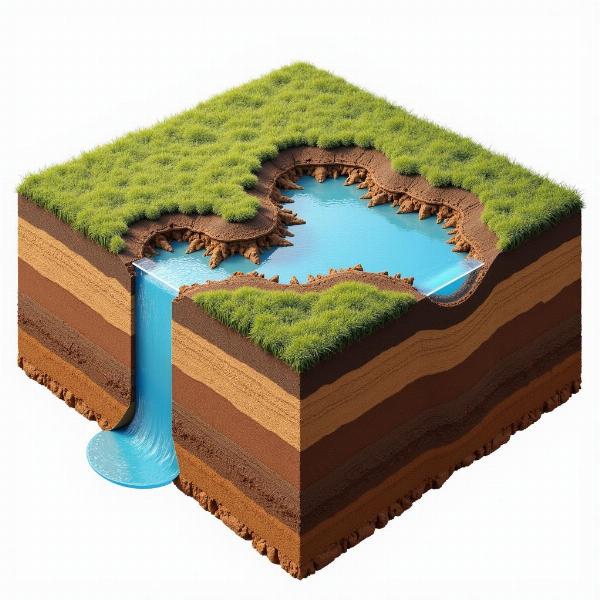Subsidence, meaning in Hindi, is a critical concept often encountered in various fields like geology, construction, and environmental studies. Understanding its meaning and implications is crucial, especially in a rapidly developing nation like India. This article explores the various facets of subsidence, its Hindi translations, causes, effects, and preventive measures.
What Does Subsidence Mean?
Subsidence refers to the gradual or sudden sinking or settling of the ground surface. This downward movement can be caused by a variety of factors, both natural and human-induced. In Hindi, subsidence can be translated as भूमि धंसाव (bhūmi dhansāv), which literally means “land sinking.” Other terms like अवतलन (avatalan) or निमज्जन (nimajjan), meaning “depression” or “submergence,” can also be used depending on the specific context.
Causes of Subsidence
Subsidence can be triggered by natural processes or human activities. Natural causes include geological events like earthquakes, volcanic activity, and the dissolution of soluble rocks like limestone and gypsum. Human activities such as excessive groundwater extraction, mining, and oil and gas extraction are also major contributors to subsidence.
Natural Subsidence
Natural subsidence often occurs over extended periods. The dissolution of underground rock formations can create cavities, leading to gradual sinking of the overlying land. Earthquake-induced subsidence can be sudden and dramatic, causing significant damage.
Human-Induced Subsidence
The most common cause of human-induced subsidence is excessive groundwater pumping. When large amounts of groundwater are withdrawn, the water pressure in the aquifers decreases, causing the soil and rock layers to compact and the ground to sink. This is a significant concern in many parts of India, where groundwater is a primary source of water for agriculture and domestic use.
 Impact of Excessive Groundwater Extraction
Impact of Excessive Groundwater Extraction
Effects of Subsidence
Subsidence can have a wide range of adverse effects, impacting infrastructure, agriculture, and the environment. These include:
- Damage to buildings and infrastructure: Subsidence can cause cracks in building foundations, tilting of structures, and damage to roads, pipelines, and other infrastructure.
- Flooding and drainage problems: Subsidence can alter drainage patterns, leading to increased flooding in low-lying areas.
- Loss of agricultural land: Subsidence can damage agricultural land, reducing crop yields and impacting livelihoods.
- Environmental damage: Subsidence can contaminate groundwater resources and damage ecosystems.
Preventing and Mitigating Subsidence
Addressing subsidence requires a multi-pronged approach. Effective strategies include:
- Sustainable groundwater management: Implementing stricter regulations on groundwater extraction and promoting water conservation practices are crucial.
- Regulating mining activities: Implementing sustainable mining practices and backfilling mined areas can help minimize subsidence.
- Monitoring and early detection: Regular monitoring of ground levels can help identify areas at risk of subsidence and enable timely intervention.
- Engineering solutions: In some cases, engineering solutions like ground improvement techniques can be used to stabilize the ground.
Subsidence and its Impact on Indian Cities
Several Indian cities, particularly those experiencing rapid urbanization and industrialization, are facing increasing challenges due to subsidence. The excessive extraction of groundwater to meet the growing water demands is a major contributing factor.
Conclusion
Subsidence, or भूमि धंसाव, is a serious issue with far-reaching consequences. Understanding its causes, effects, and preventive measures is essential for sustainable development. By adopting responsible water management practices, implementing sustainable land-use policies, and investing in monitoring and mitigation efforts, we can minimize the risks associated with subsidence and protect our communities and environment.
FAQ
- What is the main cause of subsidence in India? Excessive groundwater extraction is the primary driver of subsidence in many parts of India.
- How can subsidence be detected? Regular ground-level monitoring using techniques like GPS and InSAR can help detect subsidence.
- What are the long-term effects of subsidence? Long-term effects include permanent land loss, increased flood risk, and damage to infrastructure.
- Can subsidence be reversed? In some cases, minor subsidence can be reversed by replenishing groundwater aquifers. However, significant subsidence is often irreversible.
- What is the role of government in addressing subsidence? The government plays a crucial role in implementing regulations on groundwater extraction, promoting water conservation, and investing in research and mitigation efforts.
- How can individuals contribute to preventing subsidence? Individuals can contribute by conserving water, supporting sustainable land-use practices, and reporting any signs of ground sinking to the authorities.
- What are some examples of subsidence-prone areas in India? Several cities like Delhi, Mumbai, Chennai, and Kolkata are facing significant subsidence challenges.
epeirogenic meaning in hindi
tubewell meaning in hindi
Meaning-Hindi.in is your one-stop solution for all your Hindi translation needs. We offer a wide range of professional translation services, including business and commercial document translation, certified and legal document translation, technical and user manual translation, website and localization translation, educational and academic document translation, and express translation services. We also specialize in various industry-specific translations. Contact us today for accurate and reliable Hindi translation services. Email: [email protected], Phone: +91 11-4502-7584. Meaning-Hindi.in is committed to providing high-quality translations that bridge language barriers and facilitate effective communication.